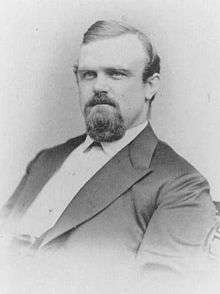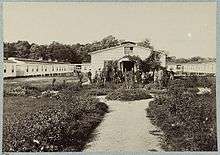Jedediah Hyde Baxter
Jedediah Hyde Baxter (March 11, 1837 – December 4, 1890) was a career United States Army officer and doctor who attained the rank of brigadier general as Surgeon General of the United States Army.
Jedediah Hyde Baxter | |
|---|---|
 Army Medical Department photo, circa 1885 | |
| Born | March 11, 1837 Strafford, Vermont, USA |
| Died | December 4, 1890 (aged 53) Washington, D.C., USA |
| Place of burial | |
| Allegiance | United States of America |
| Service/ | United States Army |
| Years of service | 1861–1890 |
| Rank | Brigadier General |
| Commands held | Campbell General Hospital Chief Medical Purveyor, U.S. Army Medical Department Surgeon General of the United States Army |
| Battles/wars | American Civil War
|
| Spouse(s) | Florence Tryon (m. 1876) |
| Relations | Portus Baxter (father) |
Born in Strafford, Vermont, Baxter was the son of Portus Baxter and Ellen Janette Harris. He received his medical degree from the University of Vermont in 1860, completed his internship and residency at Bellevue and Blackwell's Island Hospitals in New York City, and enlisted in the Union Army for the American Civil War. Assigned initially as surgeon of the 12th Massachusetts Volunteer Infantry, he later became a brigade surgeon, commanded Campbell General Hospital in Washington, D.C., and then served as Chief Medical Officer of the Provost Marshal's Bureau. Baxter took part in the Peninsula Campaign, including the Battles of Yorktown, Hanover Court House, and Seven Pines, and attained the rank of major, in addition to receiving brevet promotions to lieutenant colonel and colonel of Volunteers, and a brevet as a colonel in the regular Army.
After the war, Baxter remained in the Army as a member of the newly-organized Medical Department, and was appointed Assistant Medical Purveyor with the rank of lieutenant colonel. In 1872, he was appointed Chief Medical Purveyor, and in 1874 he received promotion to colonel. In 1875, Baxter graduated from Columbian University (now George Washington University Law School) with an LL.B. degree. Baxter's duties as Chief Medical Purveyor included serving as personal physician to the President of the United States, and he attended James A. Garfield's family. Baxter was out of town when Charles J. Guiteau shot Garfield in July 1881, and was not able to examine Garfield following the shooting. Garfield's other physicians prevented Baxter from seeing Garfield, which generated controversy both immediately after the shooting and after Garfield's death several weeks later.
In August 1890, Baxter was named the Army's Surgeon General and promoted to brigadier general. He soon afterwards became ill with uremia, which caused him to suffer a stroke. He died on December 4, 1890 and was buried at Arlington National Cemetery.
Early life
Jedediah H. Baxter, the son of Portus Baxter and Ellen Janette Harris, was born in Strafford, Vermont on March 11, 1837.[1] He attended Perkins Academy in South Woodstock and St. Johnsbury Academy, and studied at Norwich University for two years.[2] He graduated from the University of Vermont in 1859, and received his medical degree from UVM in 1860.[3] Baxter subsequently completed his internship and residency at Bellevue and Blackwell's Island Hospitals in New York City.[4]
Civil War

On June 26, 1861 Baxter enlisted for the American Civil War, joining the 12th Massachusetts Volunteer Infantry as regimental surgeon.[5][6] He served until April, 1862, when he was appointed as a brigade surgeon in the Army of the Potomac. He took part in the Peninsula Campaign, including the Battles of Yorktown, Hanover Court House, and Seven Pines.[7]
Baxter later served as head of Campbell General Hospital in Washington, D.C.[8] He ended the war as Chief Medical Officer of the Provost Marshal's Bureau with the rank of major.[9] In 1865 he received brevet promotions to lieutenant colonel and colonel of Volunteers, and in 1867 he received a brevet as a colonel in the regular Army.[10]
Post Civil War
After the war the Army's health care professionals were organized as the Medical Department, and Baxter was appointed Assistant Medical Purveyor with the rank of lieutenant colonel in the Regular Army.[11] In 1871 he received a Master of Arts degree from UVM.[12]
In March, 1872 Baxter was appointed Chief Medical Purveyor, and in 1874 he was promoted to colonel.[13] In 1875 Baxter graduated from Columbian University (now George Washington University Law School) with an LL.B. degree.[14]
Baxter's duties included serving as personal physician to the President of the United States. He attended James A. Garfield's family, but was out of town when Charles J. Guiteau shot Garfield in July 1881. As a result, Baxter did not examine Garfield following the shooting or treat him during his subsequent illness.[15][16] By the time he rushed back to Washington, Doctor Willard Bliss had taken charge and would not let Baxter see the wounded President.[17][18] According to contemporary accounts, Bliss stated that Baxter was attempting to see Garfield out of a desire for personal glory and fame, a charge which had the effect of causing Baxter to minimize his involvement so that Bliss would not seem to be correct.[19] In fact Bliss had only recently been readmitted to the District of Columbia Medical Society, which had expelled him in 1870 over his advocacy for African American doctors to be admitted. In addition, he had been expelled over willingness to consult with homeopaths at a time when most medical professionals were allopaths and disdained homeopathy. Having been readmitted to the Society so recently, Bliss likely maintained his lead role in Garfield's treatment as a way to restore his own reputation.[20][21][22]
Army Surgeon General
In August 1890, Baxter was named the Army's Surgeon General and promoted to brigadier general, appointed by President Benjamin Harrison, who was a longtime patient. Baxter's appointment had been championed by Secretary of War Redfield Proctor, a fellow Vermonter and Civil War veteran.[23][24]
Death and burial
Baxter became ill with uremia soon after assuming his new duties.[25] He suffered a stroke as a result and died in Washington, D.C. on December 4, 1890.[26] Baxter was buried at Arlington National Cemetery, Section 2, Grave 1000.[27]
Marriage
In 1876 Baxter married Florence Tryon (November 11, 1845 – February 12, 1914) of Boston, Massachusetts. They had no children.[28][29][30]
Other
Baxter was a member of the Military Order of the Loyal Legion of the United States.[31]
He was the author of 1875's Statistics, Medical and Anthropological, of the Provost-Marshal-General's Bureau. This invaluable reference work contains records and analysis of physical examinations and other medical data for more than one million men who served the Union in the Civil War.[32]
The Army hospital in Spokane, Washington was named for Baxter.[33]
References
- Association of Military Surgeons of the United States, Journal of the Association of Military Surgeons of the United States, 1905, page 59
- William Arba Ellis, Norwich University, 1819–1911, Volume 2, 1911, pages 582-584
- University of Vermont Alumni Association, University of Vermont Obituary Record, Volume 1, 1895, page 121
- Erik S. Hinckley, Tom Ledoux, They Went to War: A Biographical Register of the Green Mountain State in the Civil War, 2010, page 43
-

- Thomas Wentworth Higginson, Mary Ashton Rice Livermore, Charles Webster Wilson, Florence Wyman Jaques, editors, Massachusetts in the Army and Navy During the War of 1861–65, Volume 2, 1895, page 400
- Ellis, Norwich University, page 583
- James Evelyn Pilcher, The Surgeon Generals of the Army of the United States of America, 1905, page 74
- United States Army Medical Department, Army Medical Bulletin, Issues 57–64, 1941, page 124
- Higginson, et al., Massachusetts in the Army and Navy During the War of 1861–65, page 400
- D. Appleton and Company, The American Annual Cyclopedia and Register of Important Events, 1891, page 632
- University of Vermont, Catalogue of University of Vermont, 1791–1890, 1890, page 66
- Vermont Historical Society, Vermont History, Volume 43, 1975, page 240
- Columbian University, Historical Catalogue of the Officers and Graduates of the Columbian University, 1891, page 141
- James C. Clark, The Murder of James A. Garfield, 1993, page 42
- Martin S. Nowak, The White House in Mourning: Deaths and Funerals of Presidents in Office, 2010, page 99
- Rutkow, Ira (2006). James A. Garfield: The American Presidents Series: The 20th President, 1881. Macmillan. p. 93. Retrieved August 13, 2013.
- Millard, Candice (2012). Destiny of the Republic: A Tale of Madness, Medicine and the Murder of a President. Random House. pp. 180–181. Retrieved August 13, 2013.
- Rutkow, James A. Garfield, page 93
- Gloria Moldow, Women Doctors in Gilded-age Washington: Race, Gender, and Professionalization, page 98
- Candice Millard, Destiny of the Republic: A Tale of Madness, Medicine and the Murder of a President, 2012, page 163
- New York Homeopathic Medical Society, Documents of the New York Homeopathic Medical Society, Volume 5, 1872, page 926
- New York Times, Col. Baxter Promoted, August 17, 1890
- Ludwig M. Deppisch, The White House Physician: A History from Washington to George W. Bush, 2007, page 54
- Indiana University School of Medicine, Ruth Lilly Medical Library, Author's biography, Jedediah Hyde Baxter, accessed August 8, 2013
- Chicago Tribune, Surgeon-General J.H. Baxter Dead, December 5, 1890
- Arlington National Cemetery, accessed August 8, 2013
- Stanstead Journal, Florence Tryon Baxter, February 26, 1914
- Association of Military Surgeons, The Military Surgeon magazine, Volume 34, 1914, page 480
- Joseph Nickerson Baxter, Memorial of the Baxter Family, 1879, page 79
- U.S. Army Heritage and Education Center, Civil War Photographs Database, entry for Jedediah Hyde Baxter, accessed August 8, 2013
- J. H. Baxter, Statistics, Medical and Anthropological, Volume II, 1875, title page
- Milwaukee Journal, Hospital Takes Name From Another Baxter, December 17, 1942
External resources
- Jedediah Hyde Baxter at Arlington National Cemetery.Net
- Jedediah Hyde Baxter at U.S. Army Office of Medical History
- Jedediah Hyde Baxter at Find a Grave
| Military offices | ||
|---|---|---|
| Preceded by John Moore |
Surgeon General of the United States Army 1890–1890 |
Succeeded by Charles Sutherland |